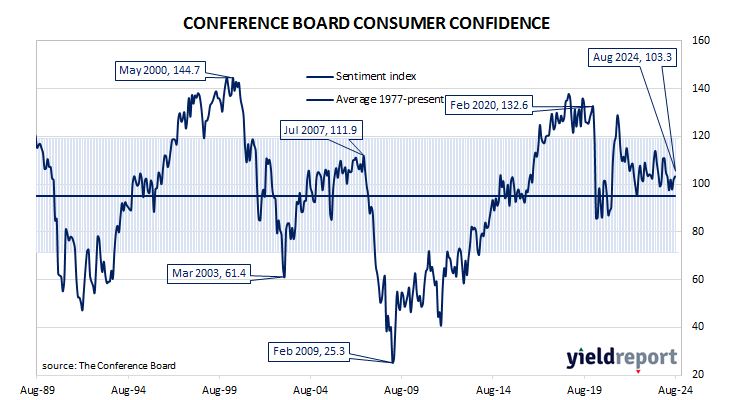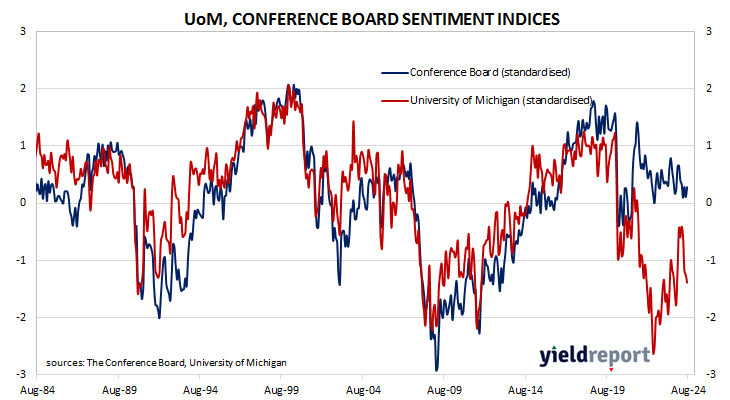Summary: Conference Board Consumer Confidence Index up in August, above expectations; more positive about business conditions but also more concerned about labour market; short-term US Treasury yields fall; expectations of Fed rate cuts harden; views of present conditions, short-term outlook both improve; expectations index still lower than in March 2001, July 1990, July 1981.
US consumer confidence clawed its way back to neutral over the five years after the GFC in 2008/2009 and then went from strength to strength until late 2018. Measures of consumer confidence then oscillated within a relatively narrow band at historically high levels until they plunged in early 2020. Subsequent readings then fluctuated around the long-term average until March 2021 when they returned to elevated levels. However, a noticeable gap has since emerged between the two most-widely followed surveys.
The latest Conference Board survey completed in the third week of August indicates its measure of US consumer confidence has continued bumping along at slightly-above-average levels. The latest reading of the Consumer Confidence Index registered 103.3 on a preliminary basis, above the generally-expected figure of 100.0 as well as July’s final figure of 101.9.
“Overall consumer confidence rose in August but remained within the narrow range that has prevailed over the past two years,” said Dana Peterson, Chief Economist at The Conference Board. “Consumers continued to express mixed feelings in August. Compared to July, they were more positive about business conditions, both current and future, but also more concerned about the labour market.”
Short-term US Treasury bond yields fell on the day while longer-term yields finished steady. By the close of business, the 2-year Treasury bond yield had shed 4bps to 3.90% while 10-year and 30-year yields both finished unchanged at 3.82% and 4.11% respectively.
In terms of US Fed policy, expectations of a lower federal funds rate in the next 12 months hardened, with around eight 25bp cuts currently factored in. At the close of business, contracts implied the effective federal funds rate would average 5.205% in September, 4.735% in November and 4.505% in December. July 2025 contracts implied 3.365%, 197bps less than the current rate.
Consumers’ views of present conditions and the near-future both improved. The Present Situation Index increased from July’s revised figure of 133.1 to 134.1 while the Expectations Index increased from 81.1 to 82.5.
“While the expectations index improved in July, rising 1.4 points to 82.5, that is still lower than in March 2001, July 1990, and July 1981, when the nation entered recession the very next month, and only a bit above the December 2007 level,” said UBS economist Amanda Wilcox. “It is also below the threshold of 90 that historically signals a recession in the next year.”
The Consumer Confidence Survey is one of two widely followed monthly US consumer sentiment surveys which produce sentiment indices. The Conference Board’s index is based on perceptions of current business and employment conditions, as well as respondents’ expectations of conditions six months in the future. The other survey, conducted by the University of Michigan, is similar and it is used to produce an Index of Consumer Sentiment. That survey differs in that it does not ask respondents explicitly about their views of the labour market and it also includes some longer-term questions.



